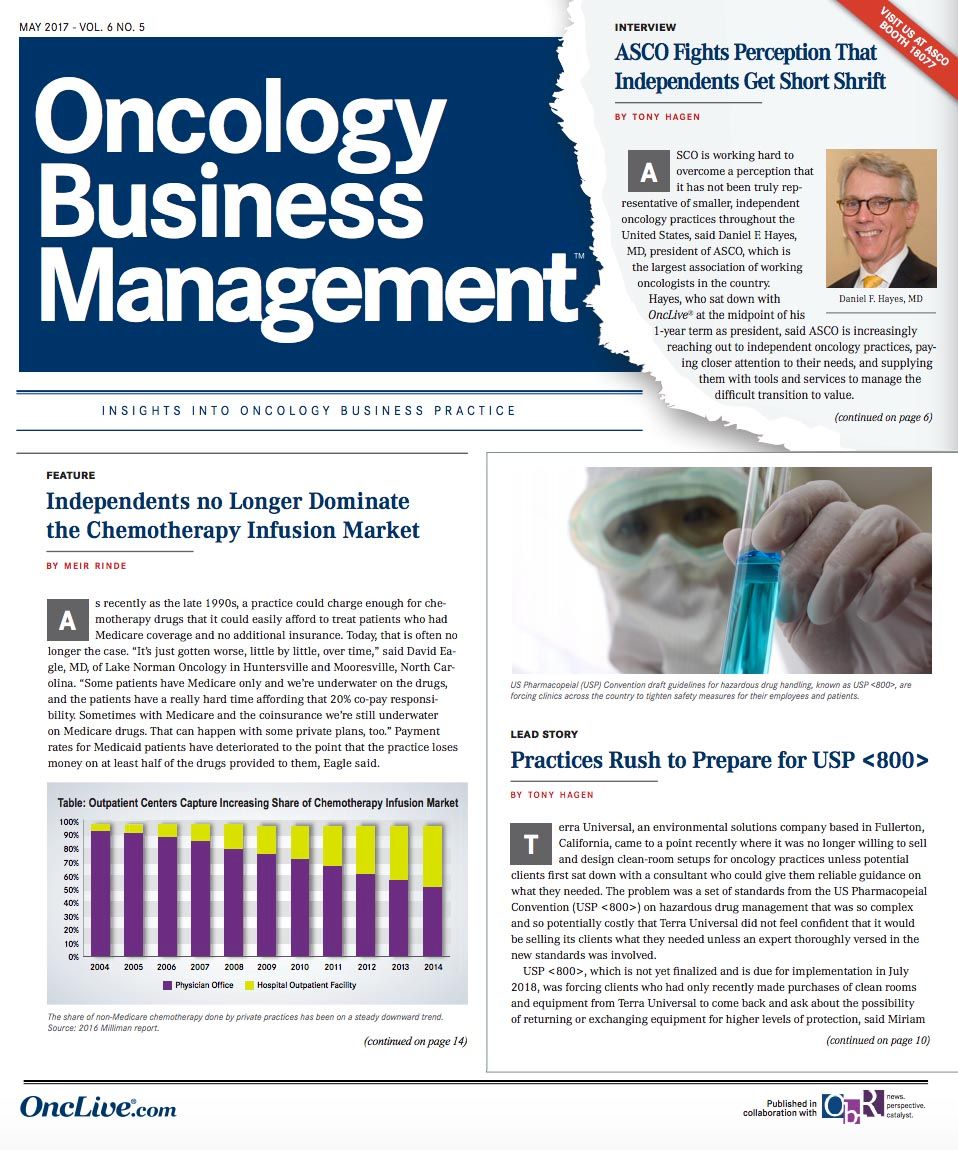Publication
Article
Independents No Longer Dominate the Chemotherapy Infusion Market
Author(s):
As recently as the late 1990s, a practice could charge enough for chemotherapy drugs that it could easily afford to treat patients who had Medicare coverage and no additional insurance. Today, that is often no longer the case.
of Lake Norman Oncology in Huntersville and Mooresville, North Carolina

David Eagle, MD
As recently as the late 1990s, a practice could charge enough for chemotherapy drugs that it could easily afford to treat patients who had Medicare coverage and no additional insurance. Today, that is often no longer the case. "It's just gotten worse, little by little, over time," said David Eagle, MD, of Lake Norman Oncology in Huntersville and Mooresville, North Carolina. "Some patients have medicare only and we're underwater on the drugs, and the patients have really hard times affording that 20% co-pay responsibility. Sometimes with Medicare and the coinsurance we're still underwater on Medicare drugs. That can happen with some private plans too." Payment rates for Medicaid patients have deteriorated to the point that the practice loses money on at least half of the drugs provided to them, Eagle said.
Infusion chemotherapy has been a core element of community oncology for decades, but for the past several years hospital networks and large cancer centers have been taking over this market. Administering intravenous therapies in-house in the community setting brings a number of advantages—lowering total costs of care and affording close monitoring of patients—but thin drug margins, the inequities of the 340B Drug Pricing Program, fierce competition for patients, and industry consolidation are making it difficult for all but the most efficient practices to stay in business and maintain viable infusion programs.
Infusion economics are also changing due to the growing use of oral drugs. Despite growing demand for cancer care and an expanding market for infusion for various other medical conditions, the chemotherapy infusion business is shrinking slightly, according to infusion industry expert Mark Huizenga, managing director of Huizenga Consulting of Grand Rapids, Michigan. Use of value-based payment models could lead to further change if cost-conscious oncologists decide to make greater use of home infusion, a rapidly growing option that is less expensive and more convenient for patients. Another potential factor is the growth of ambulatory infusion centers (AICs), though they currently provide almost no chemotherapy.
Table. Outpatient Centers Capture Increasing Share of Chemotherapy Infusion Market
Among oncology providers, the recent shift in chemotherapy siting has been dramatic. In 2004, private practices accounted for more than 80% of Medicare spending for chemotherapy infusion, but by 2014 the practices made up less than 60%, according to a Milliman study commissioned by the Community Oncology Alliance (COA).1 The change was even more stark among commercial payers, who previously paid 90% of chemotherapy claims to private practices; now, that amount totals less than 50% of claims.
Once a highly profitable, primary form of revenue for independent practices, infusion income was curtailed by the Medicare Modernization Act of 2003, which limited the amount practices can charge for drugs to 6% over average sales price (ASP). Some practices pay less than ASP for drugs and earn a bigger margin, but some—particularly smaller practices with less power to negotiate drug costs—inevitably pay more than ASP. Medicare reduced payments by another 2% following congressionally mandated sequester cuts in 2013, slicing practice revenues even thinner.
Jeff Vacirca, MD, COA’s board president and CEO of New York Cancer and Blood Specialists in East Setauket, said his practice earns about a 3% margin on drugs after a distributor takes a fee, and that doesn’t account for inventory management, bad debt—including unpaid Medicare bills—waste disposal, management, and other costs. Drug manufacturers also regularly hike their prices and it takes Medicare months to adjust its payments accordingly. “We’re seeing price increases and bad debt and all the associated practice expenses. It’s a losing situation,” Vacirca said.
Practices have the option of sending patients with insufficient coverage to a hospital for chemotherapy, but to minimize loss of oversight, such transfers generally occur only for very complex cases, patients whose payers require it, and, in some cases, indigent patients. “We always like to treat people in the office That’s our preference,” Eagle said. “It’s much easier to manage and the patients prefer it. There’s less waiting time, we have more control over the process, and there’s better coordination of care.”
Rather than send patients away, financial counselors work to get them help from charitable foundations or drug manufacturers’ assistance programs. Practices also survive by focusing diligently on billing to make sure they don’t lose out on any opportunity for revenue from payers or patients. “You can do it if you have zero room for error,” Eagle said. “Hospitals can make mistakes and stay in business. We can’t.”
Eagle and other oncologists say many hospitals worry less about running a tight ship financially because they have the cushion of the 340B program. Created by Congress in 1992, 340B allows for deeply discounted drug purchases by hospitals that serve vulnerable populations, enabling them to earn much more on each infusion than a private practice or non-340B institution. “Hospital outpatient clinics have discovered that 340B is the virtual pot of gold at the end of the rainbow,” COA executive director Ted Okon, MBA, said. Hospital networks can also use their market dominance to compel payers to agree to higher drug charges.
The profits from oncology under 340B have driven hospitals in a number of urban areas to expand their oncology programs and acquire local groups, reducing the number of independent practices in those regions. “A hospital can acquire an oncologist who accounts for upward of $4 million or $5 million in drug administration, and get [significant] discounts,” Okon said. “That oncologist represents anywhere from $2 million to $3 million of pure bottom-line profit for the hospital.” Hospital networks typically purchase practices outright, though in some cases they acquire only a practice’s unprofitable infusion services. In the latter situation, the same doctors and nurses may continue to oversee the infusions, but the new owner can boost revenue by taking advantage of 340B, the hospital’s sway over payers, and volume purchasing power.
Hospital networks also pressure other types of small practices to accept buyouts, in part so the hospitals can control where patients are steered for cancer care. In the Charlotte area, where Eagle practices, the city’s second-largest hospital recently cut ties with a large neurosurgery group and built out its own neurosurgery program, heightening worries among private oncologists in the region about a trend of declining referrals.2
Because hospitals can charge payers more for the same services than independent practices do, the shift of chemotherapy site of service increases the overall cost of cancer treatment, running counter to the movement toward more efficient value-based care. As oncologists adopt the CMS Oncology Care Model and other new payment models that emphasize population management and cost savings, alternative methods for delivering chemotherapy could gain more currency, oncology consultant Dawn Holcombe said at a recent World Congress Oncology Market Access Summit in Philadelphia. “We may decide we don’t want patients coming in the office for infusions anymore,” said Holcombe, of South Windsor, Connecticut. “We may decide we want to figure out how to manage them at home.”
The rising incidence of cancer already plays a large part in the rapidly expanding home infusion market. According to a report by Grand View Research, the global home infusion therapy business for all diseases was worth $13 billion in 2015 and is growing 6% annually.3 The market for infusion pumps specifically is projected to grow from $8.1 billion in 2016 to $10.8 billion in 2021, the MarketsandMarkets research firm said in a report.4 Chemotherapy accounts for the largest share of the pump market, exceeding diabetes, gastroenterology, and other applications.
Infusion therapies, including antibiotics and biologics for various chronic conditions, such as autoimmune diseases, are increasingly delivered at freestanding AICs run by physicians, but their chemotherapy offerings are minimal. Huizenga said that, in addition to preferring to keep patients inhouse, oncologists have more expertise in administering complex, often toxic therapies, and those oncologists in practice networks know how to make infusion work financially despite the sequester and other pressures. “Oncology physicians really do know how to do infusion and they know how to do it well. It’s very protocolized and they kind of ‘get it.’ They’ve been doing it for the longest time,” said Huizenga. Eagle said that transferring patients out of his control to a freestanding center sounded like “a terrible idea.”
Huizenga noted that succeeding in the broader infusion business for multiple diseases can be difficult and is highly dependent on the structure of the healthcare industry in a center’s local area. He pointed to Walgreens’ decision to spin off its Option Care chain of infusion centers in 2015, saying it is difficult to assemble a management team that understands the business well enough to make it profitable.
That said, AICs are succeeding, and entrepreneurial practitioners continue to show interest in opening new ones. Sending patients to an outside center for infusions can be attractive to a small practice that has only 1 or 2 infusion chairs of its own, Huizenga said. Patients with moderate disease states can go to an AIC that is less expensive and much easier to navigate than a large hospital complex, and unlike a hospital, the AIC won’t try to poach them away from the practice. Meanwhile, the sending physician can focus on treating more complex patients in-house. The practice is also able to devote less staff time and other resources to infusing drugs that provide relatively little revenue, while focusing more on other important tasks. Infusion is more profitable for the AIC because it buys drugs in volume and services a large and steady flow of patients, including on nights and weekends at some centers, Huizenga said.
References
- Milliman. Cost drivers of cancer care: a retrospective analysis of Medicare and commercially insured population claim data 2004-2014. Community Oncology Alliance website. http://www.communityoncology.org/pdfs/ studies/Trends-in-Cancer-Costs-White-Paper-FINAL-20160403.pdf. Published April 2016. Accessed March 24, 2017.
- Garloch K. Charlotte’s brain surgery battle reveals the fierce, high-dollar competition in health care. The Charlotte Observer website. http://www. charlotteobserver.com/living/health-family/karen-garloch/article134482029. html. Published February 23, 2017. Accessed March 24, 2017.
- Home infusion therapy market Is anticipated to witness lucrative growth [news release]. San Francisco, CA: Grand View Research, Inc; June 2, 2016. https://globenewswire.com/news-release/2016/06/02/845513/0/en/ Home-Infusion-Therapy-Market-Is-Anticipated-To-Witness-Lucrative-GrowthCost-Saving-Attributes-To-Act-As-Major-Growth-Drivers-Till-2024-Grand-View-Research-Inc.html. Accessed March 24, 2017.
- MarketsandMarkets. Infusion pump market by product (volumetric, syringe, enteral, insulin, implantable, PCA, accessories), application (oncology, diabetes, gastroenterology, analgesia, pediatrics, hematology) & end user (hospital, home care) — global forecast to 2021. MarketsandMarkets website. http://www.marketsandmarkets.com/Market-Reports/infusion-pumpsaccessories-market-90374506.html. Published February 2017. Accessed March 24, 2017.









